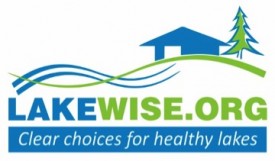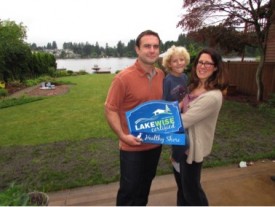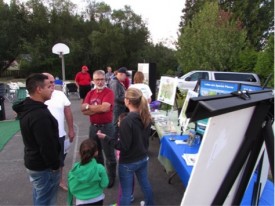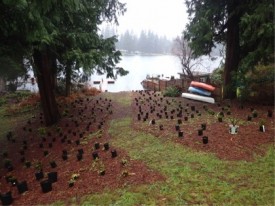by Marisa Burghdoff
The Question: “What can I do for my lake?”
 We frequently hear this question from lake residents. More often than not the answer we give has something to do with reducing pollution on their property – maintaining septic systems, picking up pet waste, etc. These and similar best management practices (BMP’s) are often the focus of public outreach and education programs and a component of watershed management plans.
We frequently hear this question from lake residents. More often than not the answer we give has something to do with reducing pollution on their property – maintaining septic systems, picking up pet waste, etc. These and similar best management practices (BMP’s) are often the focus of public outreach and education programs and a component of watershed management plans.
While the potential benefits of public outreach are high, few programs have demonstrated success with this approach. In fact, a recent article in the North American Lake Management Society’s (NALMS) magazine Lakeline — called “What Works” — argues that public outreach/education and watershed management is unlikely to reverse the effects of lake eutrophication, but might be effective in protecting unimpaired lakes. However, whether this approach works or not, there aren’t many viable options when it comes to residential non-point source pollution.
So can you create an effective outreach program to encourage residents to take action? And, can landowner changes really make a difference to lake water quality? In 2012, Snohomish County set out to answer these questions by developing a new outreach program to reverse declining water quality trends.
The Problem
Data from Snohomish County’s long-term lake volunteer monitoring program showed that most of our 36 monitored lakes are oligotrophic or mesotrophic and rarely experience problems that would affect beneficial uses of the lake. However, red flags emerge when you look at trends in the data. Statistically significant increases in summer phosphorus concentrations are occurring in 40% of the lakes. These trends are seen in either the summer hypolimnetic or epilimnetic total phosphorus averages or both. The changes are larger than would be expected over a 20-year time frame, with many lakes headed towards a higher trophic state. A few of the more affected lakes are also beginning to show signs of problems, such as more regular toxic algae blooms.
To determine the source of phosphorous, we examined the lake watersheds. Most of the affected lakes are small (15-130 acres) and located in rural settings, but with concentrated residential development around the lakes. The affected lake watersheds have little to no active agriculture, forestry, or commercial development, leaving residential nonpoint source pollution as the likely culprit. The nonpoint sources include on-site septic systems, lawn fertilizers, pet and animal wastes, and nutrient-laden sediments that run off from driveways, roofs, and other impervious or eroding surfaces. The problem is further exacerbated where residents have replaced naturally-filtering shoreline vegetation with turf grass.
Controlling inputs from these sources is challenging as the tools to address residential non-point sources are limited. Landowners may not recognize actions or property characteristics that contribute to nonpoint source pollution as harmful to water quality. Most of these sources also cannot be regulated, leaving landowner outreach as the most feasible approach. However, traditional outreach approaches that rely on increasing awareness have not been proven to bring actual changes in behavior.
The Solution
To address declining water quality in Snohomish County lakes, we first identified a list of the most important BMP’s that landowners could take to reduce non-point source phosphorus pollution. To overcome problems associated with traditional outreach methods, we investigated and applied social marketing principles to the program.
Social marketing (not to be confused with social media) is an approach to outreach that focuses on behavior change and has been widely used to address public health and environmental concerns. One of its components is identifying the current perceptions and behaviors of a target audience and the barriers and motivators to modifying behaviors. Social marketing seeks to change community norms so that beneficial actions, like implementing certain BMP’s, become widely accepted and imitated as actions that good neighbors do. One theory is that when 15% of a community adopts an action, the momentum created helps the action spread through the whole community (Rogers, 2003).
We followed well-established steps in the development of our social marketing program (Wilbur, 2006). We clearly defined the problem and possible solutions and researched other programs to learn from successes and failures. Using phone surveys of Snohomish County lake residents, we worked to identify and understand the audience, with particular emphasis on barriers and motivators for behavior changes. We then selected and tested messages and potential program elements with focus groups and refined them accordingly.
The Program
The resulting program was branded “LakeWise.” It emphasizes a set of behaviors to reduce phosphorus pollution from residential properties and addresses key barriers to adopting those behaviors: awareness, know-how, and costs. LakeWise launched as a pilot project on a single lake in late 2012. In 2015, the project got a big boost from a US Environmental Protection Agency and Washington State Department of Ecology grant that allowed us to expand to 11 target lakes. The grant also provided funds for financial incentives to overcome landowner-identified barriers from the pilot program.
The key components of LakeWise are:

LakeWise certified landowners display their new sign.
Property Certification: To become “LakeWise-certified,” homeowners must complete the nine actions on the “Clear Choices Checklist” (download checklist). Certified properties are recognized with an attractive sign for display. Waterfront residents can also receive an optional “Healthy Shore” certification by restoring their shorelines or committing to protect still-intact shorelines. Certification starts with a site visit where property owners learn about the BMP’s and receive technical support. The site visits help landowners overcome awareness and technical barriers. The LakeWise sign provides a surprisingly powerful incentive and helps develop a new social norm for a community.
Septic Care & Lawn Care Workshops: These two workshops, required for LakeWise certification, are the main way people become involved and sign up for LakeWise site visits, and have proven successful in encouraging BMP adoption (Snohomish County, 2011; Snohomish County/City of Olympia, 2015). While the workshops are valuable, it can be hard to get people to them. Grant funds allowed us to offer rebates of up to $200 for septic care, which made attendance more appealing.
Shoreline Restoration Assistance: Restoring shoreline vegetation is one of the most important BMP’s landowners can adopt to reduce phosphorus pollution and improve lake habitat. To overcome technical and social barriers to shoreline restoration, we developed demonstration projects showcasing attractive shoreline plantings that preserve views and access to the water. The professional designs developed in the process were made available to all interested landowners. In mid-project, we received EPA and DOE grants to provide free shoreline restoration for up to 40 additional property owners, but the funding required larger, 35-foot buffer widths. We modified our outreach to promote the larger, more effective shoreline restoration projects.

A community ice cream social provides a venue to learn about LakeWise and increase a sense of community.
Community Outreach: The final component of LakeWise is involving the community in promoting LakeWise. With community leaders we planned events like ice cream socials or barbecues at some of the lakes, where neighbors come to socialize and have a chance to learn about LakeWise. Community members have also promoted events using social networking sites like NextDoor or Facebook and have even gone door-to-door.
So is it working?
To significantly affect lake water quality and develop community momentum, the LakeWise program identified specific participation targets for participation. It is still too early to tell if the program is working, but we can share some initial results and lessons learned.
Participation and BMP adoption
Initial results are promising for the 11 target lakes. All told, 7.8% of the total households attended a LakeWise workshop. Of those, 2.8% have had a site visit and completed a majority of the “Clear Choices Checklist” — 1.4% are fully certified. While we are still far from reaching our targets overall, we see a noticeable increase in participation at the four lakes with more intensive community outreach. With community outreach, workshop attendance is triple that of lakes without outreach; site visits and certifications are more than five times as high (Table 1).
Table 1: LakeWise Participation 2013 – 2015
| Target Lakes with
Community Outreach (749 parcels) |
Target Lakes without
Community Outreach (2,464 parcels) |
|
| Attended Workshop | 15.4% | 5% |
| LakeWise Site Visit | 7.6% | 1.5% |
| LakeWise Certified | 3.9% | 0.6% |
The outcomes from the pilot project (with community outreach) may provide a longer-term picture of program results when we reach three years of implementation. Through 2015, 20% of the 103 households have participated in LakeWise by attending a workshop. Fourteen percent have had a site visit and completed some of the Clear Choices Checklist — 7% are fully certified.
Overall, landowners appear most willing to adopt changes involving lawn and yard care practices and picking up pet waste. Workshop attendees show high adoption rates for septic care and lawn care. The septic care workshop and rebates have helped bring about a high rate of professional inspections and at least eight failing septic system have been identified and improved as a result of the workshops.
The remaining BMP’s have not been adopted as widely. Most properties have not identified problems with eroding areas or runoff to the lake from driveways and roofs. When those are problems, though, they can be fairly major sources and fixes are more challenging, meaning slower adoption rates. Bare soils are prevalent, but only 57% of households have committed to covering them. Landowners do seem willing to adopt these BMP’s, however, and we suspect numbers will improve over time as landowners only report back when their entire checklist is completed.
| LakeWise Clear Choice | Number of Households with need for BMP (out of 92 total households) | Percentage of Households Implementing BMP |
| Avoid lawn fertilizer or use P-free fertilizer | 87 | 96% |
| Attend a FREE natural lawn care workshop | 87 | 78% |
| Scoop pet waste, bag it, and place it in the trash | 46 | 95% |
| Divert roof and driveway runoff into stable, vegetated areas | 19 | 85% |
| Fix eroding areas in yard, driveway, and parking areas | 19 | 84% |
| Cover bare soil areas with mulch or plants | 52 | 57% |
| Have septic system inspection in the past 3 years | 91 | 71% |
| Commit to have inspections every 3 years | 91 | 74% |
| Attend a FREE septic system care workshop | 91 | 84% |
*The total % includes households that have adopted a new BMP and those who were already implementing a BMP and have committed to continue the practice in the future.
Shoreline Restoration

Native plants are ready for installation as a 35 foot buffer on a lakefront property.
The results of the shoreline restoration effort have been one of the most surprising successes. In a pre-project survey, the overwhelming majority of the target audience described their willingness to plant their shoreline as “highly unlikely.” Because of its high value for the lake, though, we kept this as an optional, standalone certification with low expectations for participation. Our initial evaluation shows that, of the 77 shoreline landowners who have had LakeWise site visits, 31% are restoring their shoreline and another 10% have committed to protect their existing healthy shoreline.
In total, 25 landowners are restoring their shorelines, many with County help. While we only require 15 foot buffers for a Healthy Shore certification, most landowners are installing 35 foot buffers to qualify for grant funding. In total, 2,018 linear feet of shoreline is being restored.
But is the Lake Cleaner?
There is still the much larger question of how these behavior changes affect lake health. Unfortunately, it will be many years before any change is observable. Furthermore, the lake’s response could be slowed if internal recycling of past pollution from lake sediments has already become a factor in lake phosphorus concentrations. However, with our long-term monitoring program and continued outreach, we hope to better understand the long-term impacts of a preventive approach to phosphorus pollution.
Lessons learned so far . . .
While we don’t have all the answers, we have already learned some valuable lessons that may help other outreach efforts:
- People love a checklist. We quickly learned that people were eager to physically check off a box on a list. The checklist also doubles as a great tracking tool for program effectiveness. Tracked in a GIS-linked database, the list helps us identify which behaviors are more easily adopted, which need additional incentives, and to more precisely estimate actual behavior changes.
- Community is key. The lakes with the highest participation have been those where we cultivated good relationships with community leaders and/or planned community events to introduce LakeWise. The best ambassador for LakeWise behaviors is a neighbor who has had a positive experience with the program. Lost Lake, in particular, has strong community leaders and a 35% participation rate and 7% certification rate in less than a year. At Sunday Lake, one engaged landowner promoted the program so successfully that seven neighbors signed up for shoreline restoration, which means that 15% of the developed lake shoreline will be restored when plantings are completed.
- Adoption of easier BMPs paves the way for more difficult ones. Some BMPs on the LakeWise checklist are easier to do than others, though they may not substantially improve water quality. However, these BMPs can be stepping stones to greater investment in the program and bigger actions. Accordingly we kept the BMP about avoiding phosphorus fertilizers on our checklist, even though the 2013 statewide ban made it difficult for people to purchase turf fertilizer. Shoreline restoration is much more challenging, but we have had a good response, likely due to landowner investment in LakeWise and the financial incentive of free shoreline restoration.
- Create new materials only if they are not available. In this region there is a culture of sharing and adapting resources to meet specific program needs, so we have relied on existing publications about septic systems, natural lawn care, etc. To address information gaps, though, we are working on a landowner-friendly runoff infiltration guide to help people who currently pipe water to lakes and streams. We have also created a LakeWise plant list of the best shoreline plants in this region for restoration.
- Focus your efforts on creating new social norms. Our original intent was to focus on one or two lakes for a couple of years to get a high rate of certification, reaching that 15% threshold. This approach hastens the development of social norms and can help prevent project fatigue which often sets in after two or three years. However, the nature of our funding sources has required us to focus on a large subset of lakes, likely making our efforts less effective than if we had focused all our efforts on just a few lakes.
We will report back when we have more results, but in the meantime you can find out more about LakeWise at www.lakewise.org.
Citations:
- McKenzie‐Mohr, D. 2008. Fostering Sustainable Behavior: Beyond Brochures. International Journal of Sustainability Communication. 3:108-118.
- Rogers, Everett. 2003. Diffusions of Innovations. New York: Free Press.
- Snohomish County & City of Olympia. 2015. North and South Sound Natural Yard Care Education Evaluation Report – http://snohomishcountywa.gov/documentcenter/view/30367
- Snohomish County 2011. Final Report: Snohomish County Septic System Program. http://snohomishcountywa.gov/documentcenter/view/20699
- Wilbur, J. for Utah Department of Agriculture and Food, Salt Lake City, Utah. 2006. Getting Your Feet Wet with Social Marketing – A Social Marketing Guide for Watershed Programs. http://www.ecy.wa.gov/programs/wq/stormwater/municipal/GettingYourFeetWet1.pdf










